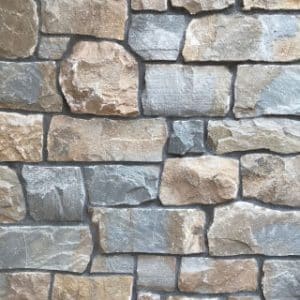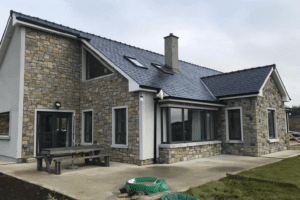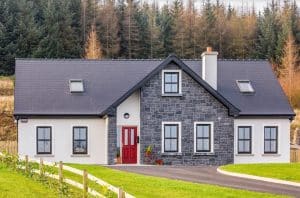Choosing the right type of stone for your project is a big decision. If you’re still trying to weigh up the options, here are some key considerations.
Natural ThinStone is more popular than ever – particularly when it comes to new-builds and retro-fitting older homes. However, a lot of people don’t fully understand the difference between ThinStone and traditional regular stone.
What is ThinStone?
In short, ThinStone is 100% natural stone that is cut down to a thickness of only one inch. The face of each stone is cut away to this one inch thickness to make each piece of ThinStone. (see image)
This process allows the stonemasons to apply ThinStone directly to a wall or surface like a heavy tile. This direct fixing method and the lower weight, give ThinStone many advantages and cost savings as against using heavy stone. Regular stone is normally about eight inches in thickness and about eight times heavier.
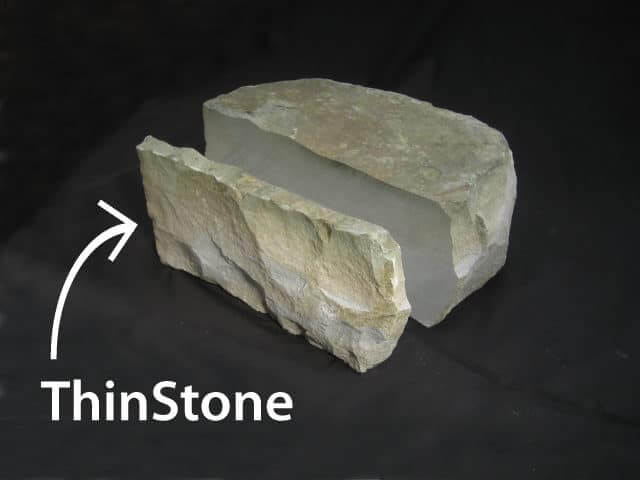
Is ThinStone Better than Regular Stone?
Existing Homes
If you are retro-fitting an existing home, then ThinStone is usually the only practical solution. This is because the overhang of the roof is not deep enough to fit eight inch regular stone underneath it. Also, the window surrounds and window sills will not be sufficiently deep to take regular stone and will need to be replaced.
ThinStone, because of its lesser thickness, works very well and avoids both of those issues. It is definitely the best solution when adding stonework to an existing home.
New Builds and extensions
For new builds or new extensions, both materials are natural and both have the same great result – a home with a natural stone feature added and a maintenance free exterior.
We will compare ThinStone with regular Stone and compare both options under the criteria of Aesthetics and Style, Installation, Cost, Stone supply and Flexibility
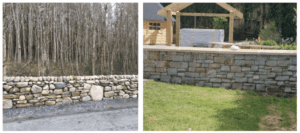
Aesthetics and Style
Like a lot of things, choosing between ThinStone and regular stone often comes down to personal taste. The best way to get an idea of which stone will best complement your home is to look at examples of finished projects and check out different types of stone.
Regular Stone
- Regular Stone has an “old world” rustic look
- It has a more chunky profile which looks very well, particularly on walls.
ThinStone
- Thinstone has a slightly more organised look
Installation
There is a very big difference in the way that regular stone and ThinStone is installed. It’s safe to say that “regular stone” projects are much harder work as they always involve heavy lifting, chiseling work on the stone and working with irregularly shaped stone.
Regular Stone
- It takes a very long time to build with regular stone. (Projects can go on for months)
- It’s often very hard to find “traditional” stonemasons nowadays
ThinStone
- A ThinStone project can be completed much faster, reducing labour cost and eliminating delays to the overall project
- Many stonemasons now solely work with lighter ThinStone cladding and offer a supply and fit service
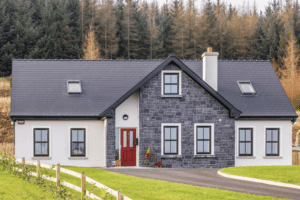
Cost
Once you’ve established the budget for your project, the next step is to identify a suitable stone supplier. Some suppliers will both supply the stone and carry out the stonework. Other suppliers, will supply the stone only, but not carry out the stonework. It is usually most practical to have one company who can offer to both supply and fit the stone.
Regular Stone
- This stone is much heavier (up to 8 times) so it needs to be supported with wider ground foundations and lintels over all windows and doors. These structural aspects are costly and often cause further complications to the overall design of the build or delays to the builder because of engineering aspects or the supply of RSJ’s and/or lintels.
- Because the work is fairly heavy and slow and the stone needs to be shaped, the labour cost is much greater.
- Ask yourself…. Can I find a local stonemason to carry out the stonework ?
ThinStone
- Even a fairly complex ThinStone project can be completed in a much shorter amount of time, usually in a week.
- Because ThinStone is light, there’s no need to make structural changes to the foundations, to the support structures over windows or doors or to the depth of the roof overhang.
Stone Supply
It’s important that your stone supplier has a continuous supply of stone that’s readily available at all times in the quantities you will need. ThinStone is normally available in the exact quantities needed. Regular stone, often from a quarry, or from a wholesaler, can very often be more problematic in terms of both supply and delivery quantity.
Regular Stone
- Quarries usually want to deliver a full lorry load of regular stone
- Smaller quantities and smaller projects are often a problem. Sometimes this may result in a pile of stone being left over
ThinStone
- Exact quantities needed are normally supplied – down to the square metre
- There will be no waste stone
Flexibility
It’s important to choose a building material that you can get the most from in terms of both design and functionality.
Regular Stone
- The need to support its heavier weight can limit design options
- Wider foundations are needed
- Support lintels and /or RSJ are required over every window and door
- Wide openings (eg: patio doors, bay windows) and corner windows are quite difficult and often lead to other complications ( eg: cold bridging, dampness etc )
- May give a great look and result if there is existing stone available, say from an old building or wall, on the site
ThinStone
- Very flexible, as it is fixed directly onto the wall, so supports and corner windows are not a problem
- Preferred by the builder as it makes his life easier and avoids awkward support issues
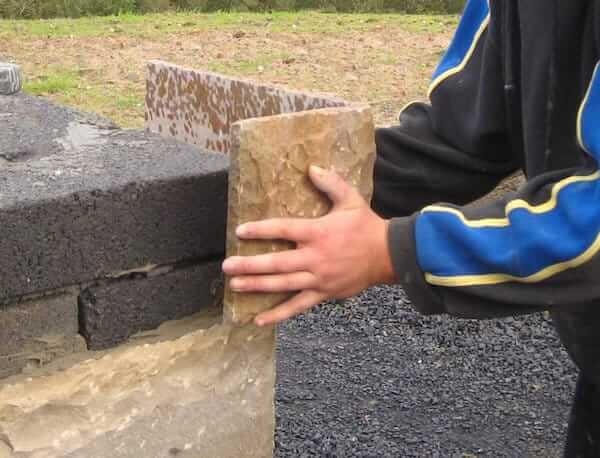
Conclusion:
Overall, it would be fair to say that ThinStone works out to be a better cost solution, a more available solution and an easier method to use.
Other advantages of ThinStone are:
- More light in to rooms than regular stone as there is less depth around windows (one inch depth of stone as against eight inches)
- Stonemasons are more easily available
- More suitable for conversions of older buildings because it fits under roof overhangs and more easily around windows
- Easier for the builder
- More suitable for internal walls, fireplaces and chimney breasts
- Projects are completed more quickly and with less complications
- Generally, more options in the type and shades of stone available

